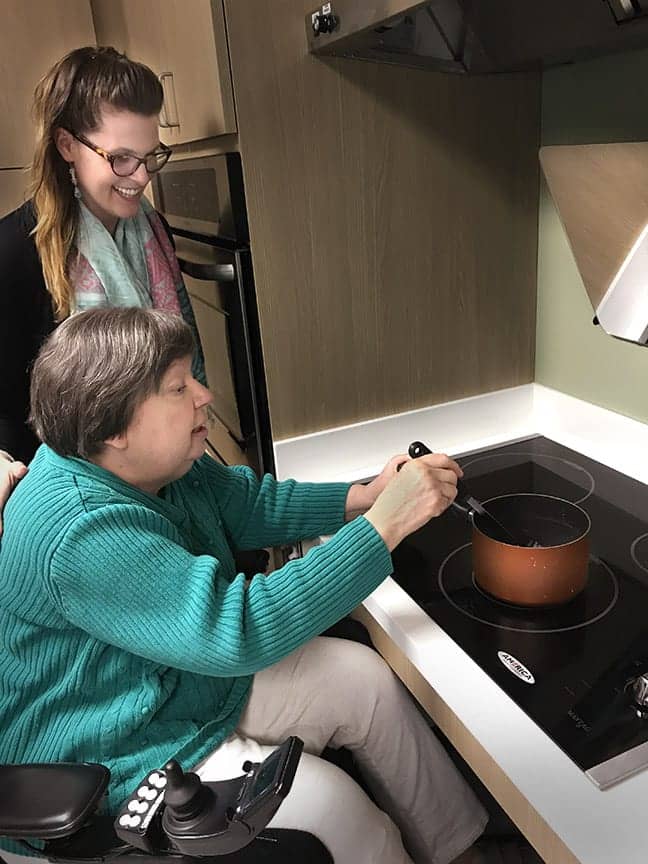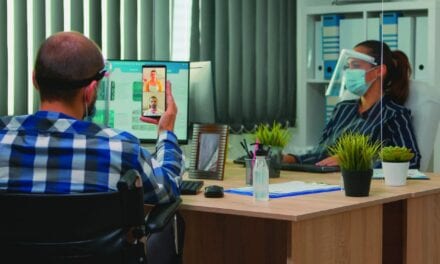
The client has progressed multiple sclerosis (MS) and has been provided with modifications of a stovetop that has open space to pull her power chair under comfortably, as well as a mirror above the stovetop so she can see what she is cooking to prevent burns and remain safe while cooking. These modifications help her to be more independent in cooking meals for herself as well as remain safe while completing an activity she enjoys.
by Joan Augustyn, OTD, OTR/L
People want to be able to live and stay in their homes. This simple truth applies regardless of whether one is thinking about planning to age in place, or has just completed a stay at the hospital or skilled nursing facility. Living in that home should also be safe. And, for people affected by disabilities, chronic conditions, or who are aging, it should not only be safe to live in their home, but the home itself should be “usable.”1 In the context of home modification, “usable” is a key term that is not interchangeable with “accessible.” In fact, the meaning of “usable” is much broader than “accessible.” “Usable” means a person may use the rooms in their home in the manner they wish. “Usable” also means that person can enter and leave the home when and how they wish. Sometimes, however, as homes grow older or as people transition to different kinds of homes, these usable features are not always present.
Evaluating Movement
Occupational therapists (OTs) and physical therapists (PTs) have a unique role because they look beyond environmental components that become apparent in screens of homes. They look at how a person moves within the environment, and this includes moving independently, with a walker or cane, a manual wheelchair, or a power chair. By looking at movement within the environment, the therapist can see which barriers and supports exist within the home. They also have insight into how the home can be a help or a hindrance to a person being social and being a part of his or her community. If entering the home is difficult, this may leave family, friends, and others from the community unable to visit a person who is affected by a disability; or leave that person feeling as if he or she cannot leave the home.
If leaving the home is difficult, being connected to the community is difficult. Not having a connection to people and the community can negatively affect the mental health of a disabled person. To combat circumstances that may cause isolation, new assessments related to home safety, a person’s ability to participate in the home, and the ability to access communities are currently being developed and tested due to the high need for these assessments and people’s desires to be able to do these things.2,3
Therapists can provide unique “client-centered” care where the client guides the selection of priorities, and the therapist provides support by contributing ideas, information, and assistance with community access (eg, how to contract for a ramp or modification that needs to be made). This model of service provision is different from a typical, medical, expert-based model. The client becomes the expert and the therapist has specific information and training to share with the client. Sometimes this model can be difficult for the client to understand, but when explained in jargon-free terms, the power transfers from the therapist or medical professional to the client.4
Home Modifications
Many times usability and safety go hand in hand. Home modification is currently a popular area of practice for occupational therapists. People are beginning to return home and stay there because of the assistance of technologies such as chair lifts, stair lifts, door opening systems, portable ramps, grab bars, zero-entry showers, systems for managing the temperature of the water in the shower, and several other home modifications.2
Bathroom Safety
For example, installing grab bars by the toilet stool can help a person who has had a stroke use the toilet stool safely in the bathroom. Many times people will note using something like a towel rack to hold onto while they move from one place to another; those towel bars are not bolted into the wall the same way a grab bar is. Having something that is securely bolted into the wall to hold on to while going from standing to sitting on the toilet stool is extremely important for a person to remain safe. Zero-entry showers make it easy for someone who uses a wheelchair or other mobility equipment to get in and out of the shower because they do not have to worry about tripping or stepping over a lip of any size to enter the shower.
New systems for managing water temperature in the shower via phone apps are also popping up, and this technology can decrease the risk of burns for people who may have cognitive differences. Another technology that enhances safety are chair lifts, which make it easier for someone who has difficulty on the steps make their way to the bedroom or kitchen safely, rather than risking balance and movement on the stairs. In some cases a ceiling-mounted track system may enable self-transfers for individuals who have lost the ability to transfer manually but who have retained limited range of motion and adequate muscle tone. These lifts can help move from bed to wheelchair, or toilet or bath. Mobile lifts on casters with adjustable bases that are built to accommodate slings and provide body weight support may also be appropriate in some cases. These lifts may be useful in lifting an individual from the floor onto a high bed, or assisting with standing and ambulation.
Door opening systems and portable ramps may also provide helpful options for a home modification strategy. Door opening systems that open automatically upon entering and leaving the home can make it easier for a person affected by a functional impairment to access the community. Especially for people who use manual or power wheelchairs, having the ability to enter and leave their home is what can connect them to their surrounding communities and prevent isolation.
Technology Basics and Budgets
A wealth of new technology is available to support the goal of enabling a person affected by a disability to live in the home. Therapists must remember that some of the best things are the basics, such as wider doors, smooth/even surfaces, and countertops that are reachable. Using technology just to use it or because it is the newest, most fashionable thing does not relate to the client’s needs. The most important aspect of home modification is that the therapist follows the client’s wishes as well as the client’s financial means.
In home modification planning, financial issues may oftentimes present a challenge to the modification goals. However, therapists can help with what is covered by insurance, what may be accessible through government funding by connecting the client to Centers for Independent Living (CILs), and what other options may be for purchasing within the community. Many funding options are available, but before they are considered the therapist must think about what the client wants and needs first.

Therapists can provide unique “client-centered” care where the client guides the selection of priorities, and the therapist provides support. This model is different from a typical, medical, expert-based model. The client becomes the expert and the therapist has specific information and training to share with the client.
Tips for Client-Centered Practice
The best way to serve an individual in the home:
1) Listen to what the client wants or needs first.
2) Assess the home and how the client moves within the spaces of their home to assess safety concerns.
3) Talk with the client about what may be possible to address any issues.
4) Connect the client with contractors, sites, community resources to get those needed items (could be as easy as a shower chair or more difficult like a ramp).
5) Follow-up with client for any needed training with new items and to see progress.
The following case study demonstrate the application of the steps:
Case Study
Norma is a 71-year-old woman who has chronic obstructive pulmonary disease (COPD), chronic back pain, and diabetes. She has neuropathy in her feet from the diabetes and walks short distances with a walker due to shortness of breath. She is now using a wheelchair most of the time to get around her ranch-style home. She lives in a small home just outside of an urban area.
After speaking to her in her home and seeing how she moves around, the OT learns that Norma wants to get onto the toilet stool and into her shower more easily (1). Currently, Norma is transferring to a bedside commode over the toilet stool in a way that is not safe (she uses no grab bars, stands on one foot, and quickly spins herself to sit down) (2). The OT offers the idea of installing grab bars, and the client agrees that she would not mind having grab bars in the bathroom (3).
Norma has a regular tub/shower combination. She notes that she does not want to redo her tub in any way because she likes the way it looks. The OT listens to her concerns and suggests a tub-transfer bench (a bench that sits partway on the outside of the tub and partway in the tub so a person can sit on it first, pull their legs over and in while sitting, and then slide across the bench all the way into the tub) (3). The client agrees as long as she can put the bench in the tub and close the curtain so no one can see when she has company.
The OT contacts a center for independent living (CIL) about who could install grab bars for her and talks to Norma about her means to purchase a tub transfer bench (4). If Norma is unable to purchase or has limited funds, the OT will look around the community for resources (4). The OT then checks on Norma’s ability to use the grab bars for safe transfers and the use of the tub transfer bench after they have been installed or given (5).
Freedom to Stay
Everyone has some kind of home or space they live in, which acts as the location in which they spend a great deal of their time. Occupational therapists devote their time and skill to making sure that people’s homes are easy to enter and leave, and that they are safe. Likewise, these professionals also assure that homes are usable and will enable the disabled people who live there to remain in the home and do the things they wish to do. RM
Joan Augustyn, OTD, OTR/L, is a clinical assistant professor at the University of Kansas Medical Center (KUMC). She received her post-professional doctorate in occupational therapy (OTD) in 2015 from KUMC. She has been an occupational therapist for 5 years and has worked in academia for 4 years. As an OT Augustyn has worked in several different medical and community settings, and currently enjoys working in a community wellness program for those who have progressed MS. Her passion is community practice. For more information, contact [email protected].
References
1. Granbom M, Evelyn-Gustave A, Gitlin L, Szanton SL. Helping older adults age in place: environmental modifications of the CAPABLE program. OT Practice. 2018;23(16):8-15.
2. Stark SL, Somerville EK, Morris JC. In-home occupational performance evaluation (I-HOPE). Am J Occup Ther. 2010;64(4):580-589. https://doi.org/10.5014/ajot.2010.08065
3. White GW, Simpson JL, Gonda C, Ravesloot CH, Coble Z. Moving from independence to interdependence: a conceptual model for better understanding community participation of centers for independent living consumers. J Disabil Policy Stud. 2010;20(4):233-240. doi: https://doi.org/10.1177/1044207309350561
4. Mroz TM, Pitonyak JS, Fogelberg D, Leland NE. Client centeredness and health reform: key issues for occupational therapy. Am J Occup Ther. 2015;69(5):1-8. https://doi.org/10.5014/ajot.2015.695001




